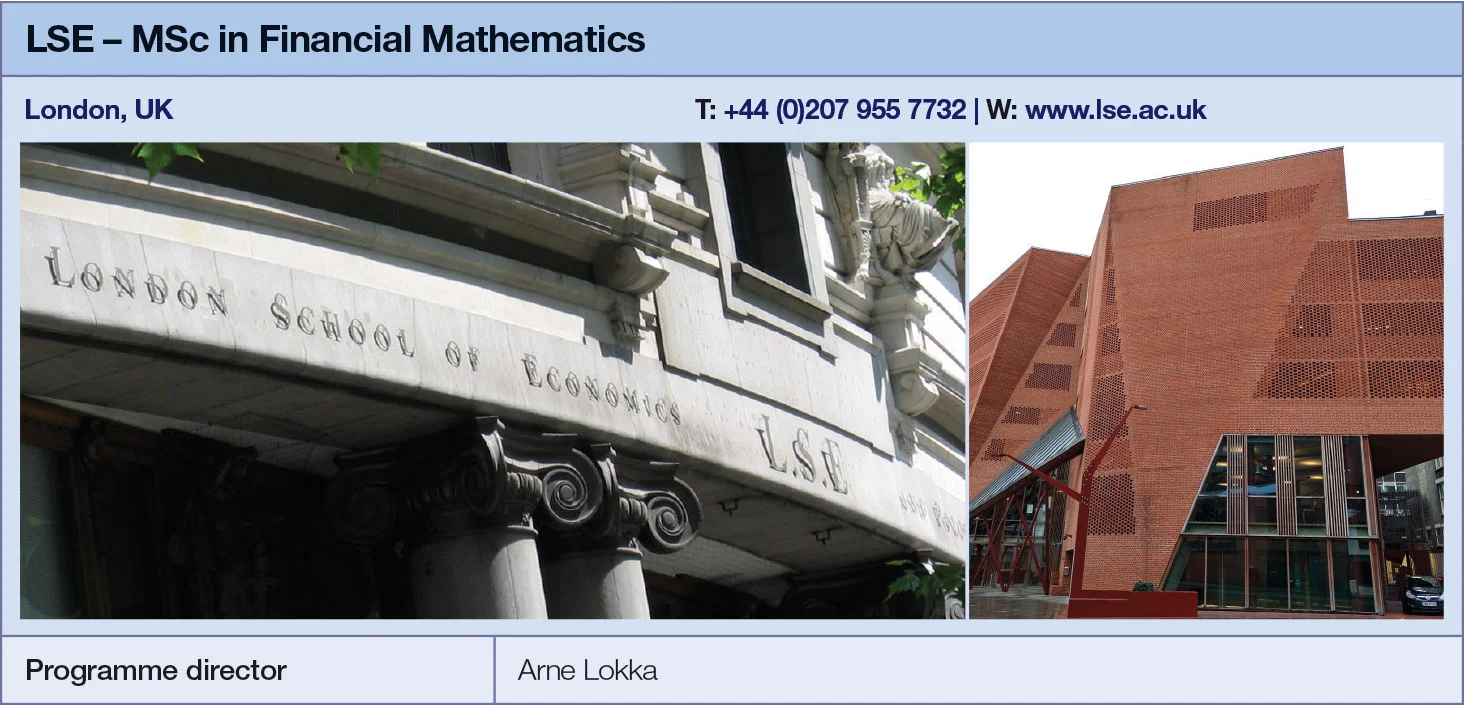
Quant Guide 2017: LSE
London, UK

MSc in Financial Mathematics | metrics table at end of article
LSE, or the London School of Economics and Political Science, offers a one-year master’s programme in financial mathematics – a collaboration between the departments of mathematics, statistics and finance. The programme is targeted at students with backgrounds in mathematics; no previous computing experience is required.
In 2014, 24 students were admitted out of 586 applicants, according to the LSE’s website. A spokesperson for the institution – which was unable to provide the requested metrics on staff ratios, research publications and citations or graduate employment rates – confirms the current 2016–17 intake is 25 students out of 683 applications.

Students are assessed in up to eight courses, five of which are compulsory. These cover Black-Scholes theory, interest rate and credit risk theory, stochastic processes, fixed-income markets, and computational methods in finance. Electives include game theory, portfolio management and probabilistic methods in risk management.
There is also the option to attend lectures on current research topics.
The computational course is spread across two terms and focuses on C++. Students take part in a total of around 22 hours of computer workshops, plus an optional 10 hours in the forecasting financial time series course.
There is one compulsory computational project, to be completed in the summer, plus further projects – not necessarily computational – for students taking elective courses in, for example, Markov processes or portfolio management.
Several seminars are hosted by the university, including some that aim to promote discussion of financial mathematical research. The LSE also co-hosts the London mathematical finance seminars series, in collaboration with other London universities such as Imperial College London.
Prior to the first term in late September, students must complete a compulsory two-week pre-sessional course to prepare them for later courses. It introduces topics in, for example, probability.

Click here for links to the other universities and an explanation of how to read the metrics tables
Only users who have a paid subscription or are part of a corporate subscription are able to print or copy content.
To access these options, along with all other subscription benefits, please contact info@risk.net or view our subscription options here: http://subscriptions.risk.net/subscribe
You are currently unable to print this content. Please contact info@risk.net to find out more.
You are currently unable to copy this content. Please contact info@risk.net to find out more.
Copyright Infopro Digital Limited. All rights reserved.
As outlined in our terms and conditions, https://www.infopro-digital.com/terms-and-conditions/subscriptions/ (point 2.4), printing is limited to a single copy.
If you would like to purchase additional rights please email info@risk.net
Copyright Infopro Digital Limited. All rights reserved.
You may share this content using our article tools. As outlined in our terms and conditions, https://www.infopro-digital.com/terms-and-conditions/subscriptions/ (clause 2.4), an Authorised User may only make one copy of the materials for their own personal use. You must also comply with the restrictions in clause 2.5.
If you would like to purchase additional rights please email info@risk.net
More on Quantitative finance
Quant Finance Master’s Guide 2026
Risk.net’s guide to the world’s leading quant master’s programmes, with the top 25 schools ranked
Baruch, Princeton cement duopoly in 2026 Quant Master’s Guide
Columbia jumps to third place, ETH-UZH tops European rivals
Quant Finance Master’s Guide 2025
Risk.net’s guide to the world’s leading quant master’s programmes, with the top 25 schools ranked
Baruch maintains top spot in 2025 Quant Master’s Guide
Sorbonne reclaims top spot among European schools, even as US salaries decouple
Quant Finance Master’s Guide 2023
Risk.net’s guide to the world’s leading quant master’s programmes, with the top 25 schools ranked
Baruch topples Princeton in Risk.net’s quant master’s rankings
US schools cement top five dominance as graduate salaries soar
Is it worth doing a quant master’s degree?
UBS’s Gordon Lee – veteran quant and grad student supervisor – asks the hard question
Starting salaries jump for top quant grads
Quant Guide 2022: Goldman’s move to pay postgrads more is pushing up incomes, says programme director







